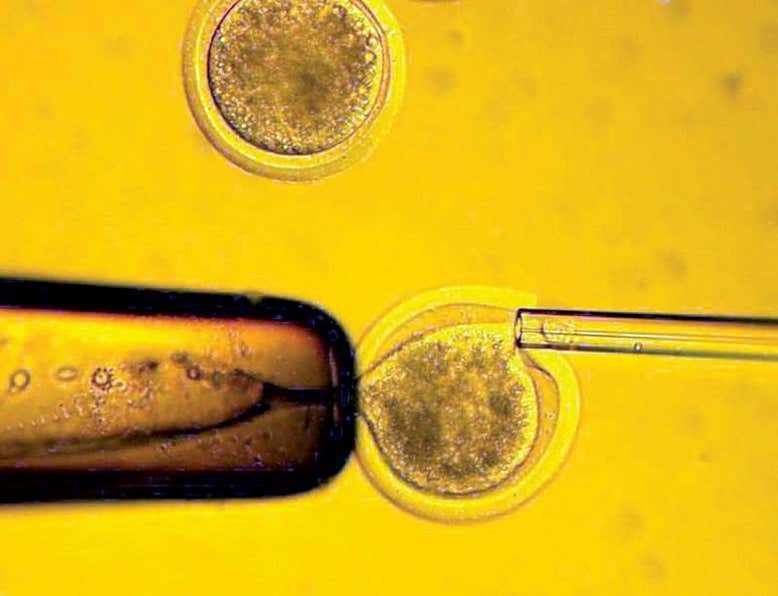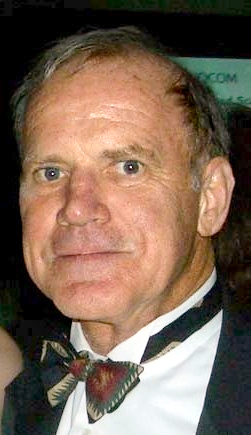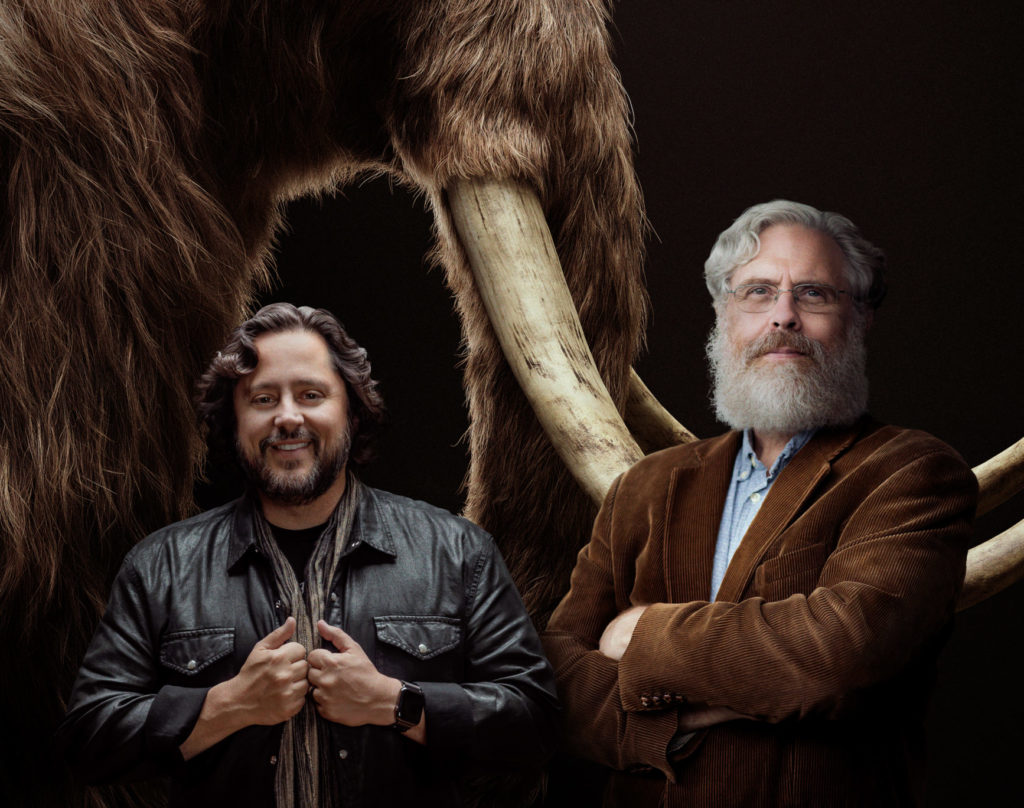

Co-FOunder
George Church
George Church
THE FATHER OF MODERN GENOMIC SEQUENCING
George Church, Ph.D acts as the co-founder and lead geneticist for Colossal. Additionally he serves as the head of the Wyss Institute, while also independently running Church Labs at Harvard. Currently also a professor at Harvard and MIT, Church is the recognized leader in genomics, pioneering a number of advances and breakthroughs that have progressed the entire field of genomics.




What exactly is genetic engineering? Why is it so important? And how are we applying it? Read below to better your understanding of this complex field of study.
Genetic
EngineerinG:
Basics
Genetic engineering is best defined as the act of modifying an organism’s DNA sequence with the use of biotechnology. Genetic engineering can be used for editing a single base pair of DNA, multiple base pairs of DNA (a sequence), to editing entire genomes by either up-regulating, down-regulating, knocking-in or knocking-out genes (e.g. insertion, deletion or replacement of specific genetic material).
There are numerous techniques for genetic engineering, with the most common and widely used technique being CRISPR.
At Colossal, we currently focus on the application and advancement of CRISPR for the purposes of de-extinction and climate change reversal.


GEORGE CHURCH: A LIFETIME OF GREAT ACHIEVEMENT THE MAN BEHIND THE METHOD
In 1984 with Wally Gilbert, Church developed the first direct genomic sequencing method and barcode-multiplexing tags.
This led to automation and software used for the first cellular genome sequence (Helicobacter) in 1994, which evolved into ‘in-situ sequencing’ (1999) and ‘next-generation sequencing’ (2014). Church then pioneered chip-based DNA libraries, genome editing, and stem cell engineering. He also pioneered new privacy, biosafety, human engineering, environmental, biosecurity, and bioethics strategies and training. Today, he and his group champion open-access human genome data.
For his achievements and direct contributions to genomics and the sciences as a whole, Church has received numerous awards. Some of his most prestigious recognitions include National Academy of Sciences, National Academy of Engineering, the Heptannual Bower Award, and Prize for Achievement in Science from the Franklin Institute. In sum, he has co-authored 537 papers, 156 patent publications and published one book.
Select Achievements

Zoology and Chemistry B.A. from Duke University
Biochemistry and Molecular Biology PhD Harvard University
Professor of Genetics at Harvard Medical School
Professor of Health Sciences and Technology at Harvard and MIT
Director of the DOE Technology Development Center (Present)
Director of NIH NHGRI Center of Excellence in Genomic Science (Present)
Director of the Personal Genome Project
In his lifetime, George Church has helped create
Published Papers
Secured Patents
Companies
and devoted countless hours to making the world a better place.
Select Awards
World Economic Forum Technology Pioneer Awards (LS9 and 23andme)
American Society for Microbiology Biotechnology Research Award
Consumer Genetics Champion & Public Initiative Award
US Presidential and EPA Green Chemistry Award (LS9)
Triennial International Steven Hoogendijk Award
Personalized Medicine World Conference Lifetime Achievement Award
Franklin Institute Bower Prize for Achievement in Science
National Academy of Sciences USA (Chemistry)
National Academy of Engineering USA (Bioengineering)

WORKING
TO HEAL
THE
WORLD
Genetic engineering is used to help humanity advance treatments for genetic disorders, gene therapies, DNA fingerprinting, vaccines and pharmaceutical products. Further applications include sustainable plant and animal food production, diagnosing diseases and conditions, medical treatment improvement, as well as production of vaccines and other useful drugs.
Genetic engineering applications of animals include advancing human health, enhancing food production, reducing environmental impact, optimizing animal health and welfare and production of cutting edge industrial applications. Other world-bettering uses include eradicating malaria, organ donorship, and of course, the slowing of and reversal of the extinction of species.


“It's all too easy to dismiss the future. People confuse what's impossible today with what's impossible tomorrow.”
• George Church

“Working toward a Colossal achievement like bringing back an extinct species is the kind of thing that our brightest minds want to do.
Colossal's ambition is an inspiring example of what can be done, and the technological by-products of doing it will invigorate the industry of generic engineering. I am excited to see this happen as fast as possible, because a new generation of bright minds, using this new technology, can do something about the ecological crisis they are inheriting. Our unbridled exploitation of nature has fought a war with evolution, and the natural world doesn’t have a chance without us. Precision genetic engineering can begin to reverse this damage, by creating bacteria that eat plastic, corals that are resilient to heat, and restoring ecological balance in threatened habitats.”

Founder and creator of Siri, product designer and Stanford AI researcher
[ Colossal Executive Advisory Board Member ]

By
Definition
[ CELLS / NUCLEUS / CHROMOSOMES / GENES / DNA / RNA / CAS9 ]

Cells are the basic building blocks of all living organisms. The human body is composed of trillions of cells. A cell provides structure for the body. A cell can take in nutrients from food and convert the nutrients into energy. Cells perform many functions, and thus contain specialized parts for each function, called organelles. The organelle that contains hereditary information is called the nucleus.

The nucleus is located inside the cell. The nucleus is where all genetic material, i.e. DNA, is stored in the form of chromosomes. In addition to storing all of the genetic information of the cell, the nucleus acts as the cell’s command center, sending directions to the cell signaling that it's time to grow, mature, divide, or die.

Inside the nucleus, DNA molecules are packed into thread-like structures called chromosomes. The human genome contains over 3 billion base pairs of DNA, in order for the nucleus to be able to hold all of this genetic material, it has to be stored as tightly wound DNA structures. The amount of chromosomes inside a nucleus varies from species to species. Human beings have 46 chromosomes, while elephants have 56 chromosomes. The amount of genes on each chromosome varies from chromosome to chromosome.

A basic unit of heredity and a sequence of nucleotides in DNA or RNA that encodes the synthesis of a gene product, either RNA or protein, found in all living things; some genes form a set of instructions for the manufacture of proteins. Colossal has already sequenced the genes of both the Asian Elephant and the Woolly Mammoth.

Deoxyribonucliec acid, the molecule inside cells that contains genetic information responsible for the development and function of an organism; DNA is made up of a double-stranded helix held together by a sugar-phosphate backbone and weak hydrogen bonds between purine-pyrimidine nucleotide base pairs: adenine (A) paired with thymine (T), and guanine (G) paired with cytosine (C)

Ribonucleic acid, a nucleic acid that acts as a messenger carrying instructions from DNA for controlling the synthesis of proteins; however, in certain viruses, RNA rather than DNA contains the genetic information

Cas9 (CRISPR associated protein 9) is a 160 kilodalton protein which plays a vital role in the immunological defense of certain bacteria against DNA viruses and plasmids, and is heavily utilized in genetic engineering applications; its main function is to cut DNA and thereby place new DNA to alter a cell's genome

A science
that started
in 1953.
A science
that started
in 1953.
The field of genetics truly began when James Watson (USA) and Francis Crick (UK) published a scientific paper called "Molecular Structure of Nucleic Acids: A Structure for Deoxyribose Nucleic Acid" in the scientific journal Nature. This world-changing piece was the first to define and describe the double helix shape of DNA. Ultimately, this started a wave of interest in genetics by the scientific community, and in the years since, as technology has advanced, the field of genetics has advanced along with it. For example, the more powerful microscopes grew, the more scientists could visualize and manipulate. Ultimately, leading to where we are today, with a process as complex and precise as CRISPR Cas9 genome editing.


Genetic Engineering: Past to Present
ScrollSwipe Right >>>>
Rosalind Franklin captures images of DNA structure using X-ray diffraction.

James Watson and Francis Crick discover the double helix structure of DNA. Awarded the Nobel Prize in Physiology or Medicine 1962.

Arthur Kornberg isolates and identifies the protein DNA polymerase and the four nucleotides: A, G, T, and C. Awarded the Nobel Prize in Physiology or Medicine in 1959.

Osamu Shimomura isolates the green fluorescent protein (GFP) naturally present in Aequorea victoria, Jellyfish. Martin Chalfie and Roger Tsien developed this protein into an essential biological tool that when tagged to a protein will emit a green light when exposed to a blue wavelength. Awarded the Nobel Prize in Chemistry in 2008.

Gellert, Lehman, Richardson, and Hurwitz laboratories discover the protein, DNA ligase, responsible for facilitating the joining of DNA strands together.

Werner Arber isolates a restriction enzyme, a protein, in E. coli. The restriction enzyme can identify and ‘cut’ foreign DNA that enters the bacteria’s genome. Awarded the Nobel Prize in Physiology or Medicine in 1978.

Paul Berg cuts the DNA of two different viruses and incubates them together, allowing them to combine. Awarded the Nobel Prize in Chemistry in 1980.

Daniel Nathans advances capabilities with restriction enzymes DNA cutting processes. Awarded the Nobel Prize in Physiology or Medicine in 1978.

Hamilton Smith identified the 6 base pair DNA sequence that Hind II, a restriction enzyme found in the bacterium Haemophilus influenzae, recognizes and cleaves. This understanding of how DNA restriction enzymes ‘cut’ DNA forms the basis for today’s CRISPR. Awarded the Nobel Prize in Physiology or Medicine in 1978.

The National Academy of Sciences proposes a temporary moratorium on all genetic engineering experiments.

100+ scientists gather at the Asilomar Conference to establish an ethical framework on genetic engineering.

George Kohler and César Milstein merge myeloma cells (cancerous plasma cell) and human B cells (white blood cells belonging to the immune system) - creating a rapidly dividing cell (myeloma trait), allowing for large numbers of antibody producing cells (B cell trait) to grow. Antibodies belong to the immune system and help fight infection by attaching to foreign material that has entered the body.

Thomas Wagner transfers the gene of a rabbit into the genome of a mouse.

Dennis Kleid, a Genentech scientist, genetically engineers the first human synthetic drug: insulin.

Kary Mullis discovers the polymerase chain reaction (PCR) technique. PCR is used to make many copies of a specific DNA segment.

Pablo D. T. Valenzuela creates the world’s first recombinant vaccine, Hepatitis B vaccine, using yeast cells.

The first official GMO crop, corn, appears in the U.S. - known as ‘Bt Corn’, containing genes from the bacterium Bacillus thuringiensis to deter pests.

Francisco Mojica discovers clustered regularly interspaced palindromic repeats, later termed CRISPR, in bacteria.

Ian Wilmut and team of the Roslin Institute clone the first mammal, Dolly the sheep.

The first gene-targeted drug therapy, Glivec, is approved by the United States FDA.

The International Human Genome Sequencing Consortium, led in the United States by the National Human Genome Research Institute and the Department of Energy, announces the completion of the Human Genome Project. For the first time in history the human genome is sequenced.

The United Nations formally endorses biotech crops.

The only preventative cancer vaccine, Gardsil, is developed using gene-editing techniques to find cancer treatments and is a recombinant vaccine.

Dr. Shinya Yamanaka pioneers the induced pluripotent stem cell (iPSC) technology.

Craig Venter and his team create a synthetic genome for the bacterium Mycoplasma mycoides and transplanted this genome into a different bacterium Mycoplasma capricolum, creating new cells which would be controlled by the synthetic Mycoplasma mycoides genome. This is the world’s first synthetic life form.

Jennifer Doudna and Emmanuelle Charpentier pioneer the cellular mechanisms of CRISPR as biotechnology. Awarded the Nobel Prize in Chemistry in 2020.

The first human trials for CRISPR are approved.

Crispr


CRISPR is an engineered cellular technology used for recognizing and cutting a specific code of DNA inside the nucleus. Once this DNA is cut, a laboratory modified version of DNA is inserted and reanneals the cut DNA by binding to the specific code.
CRISPR technology is originally an innovation of nature and was first observed in bacteria, specifically in its non-membraned, simple cells. But, scientists have been able to re-engineer this CRISPR technology to work in eukaryotic cells - meaning cells with a nucleus and organelles, all enclosed in a plasma membrane. These are the types of cells humans and animals have.
In mammalian cells, such as an elephant or a Woolly Mammoth, CRISPR works with an enzyme called Cas9 to modify genes. A CRISPR-Cas9 complex will use a single guide RNA from CRISPR to guide and recognize a specific sequence of DNA, where the Cas9 molecule will cleave those strands that are complementary to the CRISPR sequence. This allows for the reinsertion of the laboratory engineered DNA, as mentioned on the image below. Ultimately, giving us the ability to insert cold-resistant characteristics into elephant DNA - leading to the de-extinction of the Woolly Mammoth.


Crispr-Cas9
How The Genome Editor Works
The Cas9 protein forms a complex with guide RNA in a cell
This complex attaches to a matching genomic DNA sequence adjacent to a spacer
The Cas9-RNA complex cuts the double strands of the DNA
Programmed DNA may be inserted at the cut


Fortune “World’s 50 Greatest Leaders”, prolific entrepreneur involved with such advancements as founder of Singularity University, founder of X Prize Foundation, co-founder of BOLD Capital Partners, NYT Best Selling Author, Molecular Genetics & Aerospace Engineering Degrees from MIT, M.D. from Harvard Medical School
[ Colossal Executive Advisory Board Member ]

Leading
the
Charge
the
Charge
In addition to Church’s extensive contributions to CRISPR and genomics, Church has been leading the field of de-extinction across the world. He has extensively studied the Woolly Mammoth genome, leveraged CRISPR for de-extinction, and is recognized as the world leader in reviving the Mammoth.
He’s been featured in articles ranging from 60 minutes to National Geographic to The Wall Street Journal on his progress. Church is also mentioned numerous times and has an entire chapter in Walter Isaacson’s book on CRISPR pioneer, Jennifer Doudna.

Regenisis
In their book, Regenesis, George Church and science writer Ed Regis co-authored an exploration of future-facing scientific advancements and the possibilities these may unlock. The narrative aptly centers around the subject of synthetic biology—a study in which the genomes of living organisms are selectively altered, thus allowing for the creation of entirely new species.
Some theories, although they may look great on paper, never leave the page. However, those expressed by Church and Regis in Regenesis have come to serve as the foundation for Colossal’s own DNA. And with every scientific breakthrough, another vision graduates from theory to practice—exemplified by the massive progress the Colossal team continues to make every day.
It’s the story of a once invisible being, nameless for eons, now called ‘the genome.’ Its being—its existence across time, its depth and complexity as a natural artifact, and the vast abundance and variety of its manifestations—is the story. It is ancient and modern, older than our oldest ancestor and yet fresher than a newborn baby. It has covered our planet with its descendants, now over a billion times a billion times a billion copies.
Publisher’s Description
These technologies—far from the out-of-control nightmare depicted in science fiction—have the power to improve human and animal health, increase our intelligence, enhance our memory, and even extend our life span. A breathtaking look at the potential of this world-changing technology, Regenesis is nothing less than a guide to the future of life.
















